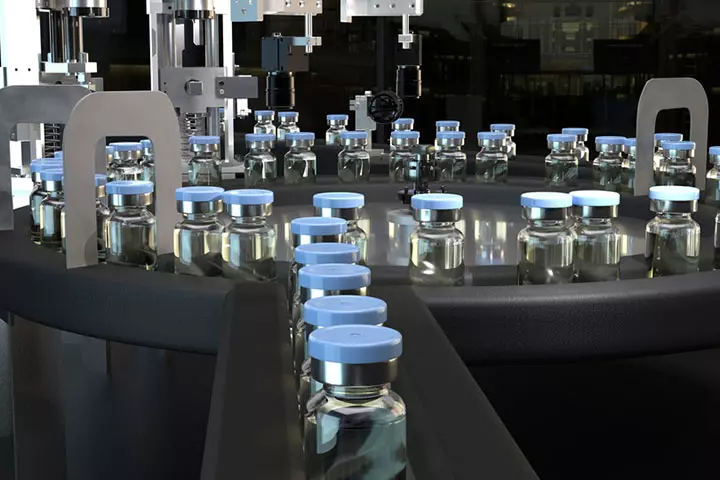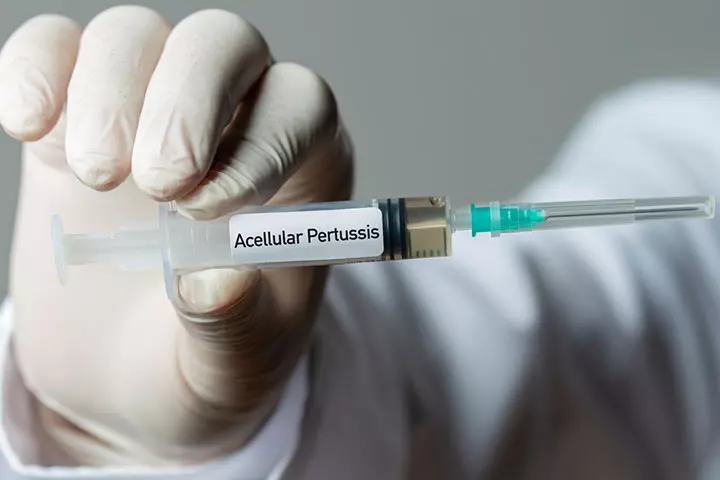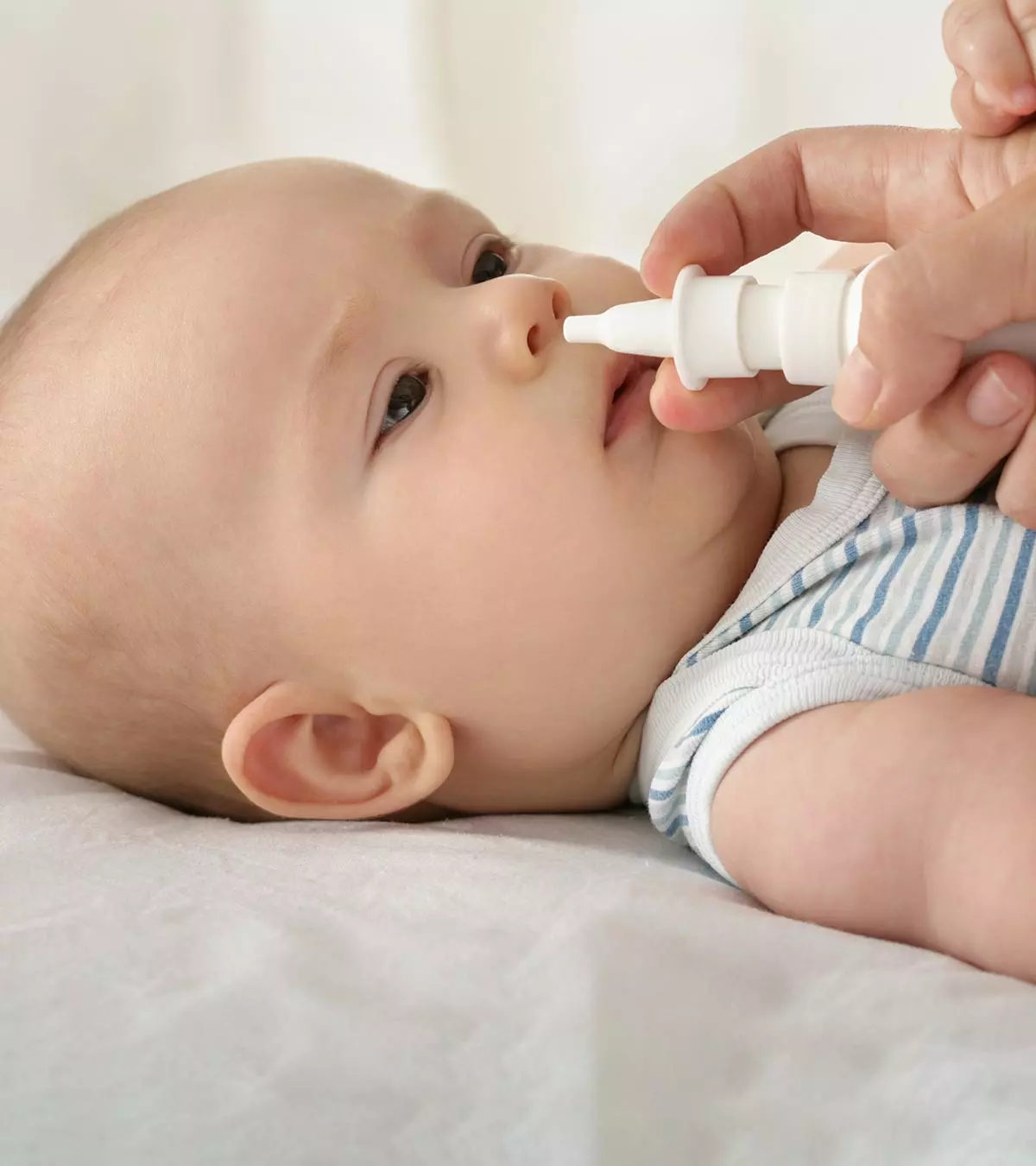
Image: Shutterstock
Parents may consider painless vaccinations for babies to avoid the anxiety associated with vaccinating infants and reduce the discomfort for the little ones. Research indicates that 24-40% of parents in the US and Canada show concern about the pain associated with vaccinations in children. 85% of parents believe that healthcare providers should take the responsibility of making vaccinations less painful.

Read this post to know what painless vaccination is, its advantages, its limitations, and the potential cost.
Key Pointers
- Painless vaccines include oral or intranasal vaccinesiVaccine administered through the nose that usually does not cause any pain and acellular injectable vaccines, which cause less pain and inflammation.
- These vaccines cause milder episodes of pain, fever, and other systemic adverse effects than whole-cell injectable (painful) vaccines.
- Licensed and recommended painless vaccines are safe and efficacious.
What Are Painless Vaccines?
Vaccination can cause pain either due to the method of delivery or due to post-vaccination reactions. Conventional or painful vaccines that are delivered through a syringe or injection often cause pain and tenderness at the injection site. However, pain during vaccination sessions is manageable and managing pain does not decrease the efficacy of the vaccine. Also, there are a number of painless vaccine delivery systems in practice.
The painless routes of administration include oral and nasal.
Despite the benefits of the painless route of delivery, to date, most of the vaccines are available as injection shots only.
 Research finds
Research findsPainless mucosal vaccines:

- Intranasal influenza and oral polio vaccines are examples of successful, painless mucosal vaccinations that help safeguard your newborn against harmful diseases. These vaccines are cost-effective compared to the injections and are ideal for vaccinations of the mass population (1).
- Flumist is one of the live attenuated influenza nasal vaccines for children against the influenza virus. Rotarix and RotaTech against rotavirus, Dukoral for cholera, Vivotif against typhoid fever, and Sabin live OPV (oral polio vaccine) are some of the licensed oral vaccines (2).
- These vaccines are easy to administer, safe, and several of the vaccines do not require cold chain maintenance (storage under low temperature until delivery). In comparison, an injection vaccine could require an unbroken cold chain during production, storage, and distribution.
- Oral polio vaccines have been a great success, and it helped eradicate polio in countries like India. The country was listed by the global polio eradication initiative (GPEI) as the most difficult region in the world to eliminate wild poliovirus transmission (3).
The nasal and oral route makes for a painless vaccine administration. However, when there is a discussion of painless vaccination, most think of painless injection vaccines, which have been a current trend in many countries.
What Are Painless Injection Vaccines?

Acellular vaccines are known as painless vaccines. This type of vaccine contains a part of the cell, such as the antigenic part, then a complete cell of pathogens. The acellular vaccines are called painless since less immune reaction occurs after the delivery of vaccines compared to the body’s response to a whole-cell vaccination.
Painless vaccines are not exactly painless, and babies may still have pain due to injection. The pain in babies is usually noted based on post-vaccination behavior such as crying.
One of the main painless vaccines for babies is the DTaP vaccine, which contains diphtheria and tetanus toxoids (chemically modified pathogenic toxin) and an antigenic component of Bordetella pertussisiA pathogenic bacterial species that causes whooping cough .
 Point to consider
Point to considerIs It Safe To Give Painless Vaccinations For Infants?

All licensed and recommended vaccines are safe and effective because they are made with high safety standards. Vaccines are licensed by the Food and Drug Administration (FDA) and recommended by the US Centers for Disease Control Prevention (CDC) after several years of safety tests and evaluation. Every batch of vaccines undergoes quality control before use (4).
If your country’s policies include acellular vaccines in the immunization schedule, then you may choose them based on the pediatrician’s advice. It is important to vaccinate your child for pertussis, and it doesn’t matter if your child receives a whole-cell painless or painful vaccination since both can create effective immunity against the disease (5).
Painless Vs. Painful Vaccination – Which Is Better?

All licensed and recommended vaccines are effective. The following are some essential points about painless versus painful vaccination.
- According to the CDC, the studies conducted to evaluate the effectiveness of acellular vaccines have shown them to be as effective as whole-cell vaccines (6).
- Three doses of acellular vaccine can produce a similar range of protection against moderate and severe pertussis disease as a whole-cell vaccine. The local reactions, such as pain, swelling, redness, and systemic reactions such as fever, were mild in acellular or painless vaccination (6).
- Severe adverse effects such as persistent crying (crying for more than three hours), high fever, hypotonic and hyporesponsive episodesiAdverse reactions to vaccinations causing symptoms such as weak muscle tone and reduced consciousness , and febrile seizure were less frequent among infants, who received DTaP (6).
Limitations Of Painless Vaccine
During the pertussis outbreak in 2009 and 2010, teens who were vaccinated with DTaP in infancy had a higher risk of contracting pertussis than the teens who received the whole-cell vaccine (7).
Due to the outbreaks of pertussis reported in some countries despite the use of acellular pertussis vaccine, the Indian Academy of Pediatrics recommends the whole-cell vaccine for primary immunization in infants, and the acellular vaccines only for specific cases (5).
Many industrialized countries use acellular vaccines. The lasting immunity and requirement of a booster dose in teens may have to be studied further for more details. Your child’s pediatrician can also give you information about any ban on painless vaccinations in your country.
Despite the several instances of comparison between the painless and painful versions of the vaccine, there is a scarcity of conclusive data about the effectiveness of DTP and DTapvaccines. More case-control studies are required to look for the rare severe adverse effects such as encephalopathy and anaphylactic shock (lower blood pressure due to anaphylaxis or an allergic reaction).
Advantages Of Painless Vaccination
Compared to whole-cell vaccines, acellular vaccines are less painful and cause a minimal post-vaccination reaction. Advantages of painless vaccination may include:
- Less systemic reactions, such as high fever, hypotonia, etc.
- Low rates of local reactions such as swelling and redness (erythema) at the injection site.

Clinical trials have shown that acellular vaccines have a lower rate of adverse events than whole-cell pertussis vaccines. However, this may still cause pain. Studies report that a few infants experience vaccination side effects, such as severe pain (8).
What Is The Cost Of Painless Vaccination For Babies?
Painless vaccination may cost more than older whole-cell vaccines. You may seek advice from your baby’s pediatrician for a routine vaccination schedule, available vaccines, and costs. Vaccine prices may vary in different countries, and some may get free vaccination as per the government policies.
Daptacel, Infanrix, Kinirix, Pediarix, Pentacel, and Quadracel are available licensed pediatricDTaP vaccines in the US (9). These vaccines can cost from $21 to 70 if you go for immunization programs included in the CDC funds, such as the state health departments. Private sector vaccinations may cost around $30 to 120 (10).
One time booster dose is also recommended for adults, especially those who are in contact with children younger than 12 months (11). The booster shot for adults and older children may incur an extra cost. You may seek your healthcare providers’ advice to choose the appropriate immunization programs which are convenient and cost-effective.
Frequently Asked Questions
1. Do babies sleep after immunization?
Yes. It is normal for babies to feel unsettled or sleepy after immunization (12).
2. How long does it take for babies to recover from the side effects of vaccines?
Mild side effects of vaccines often go away on their own after two to three days (13).
3. Do all babies get fever after vaccination?
No. Getting a fever differs from one baby to another. A few babies might not get a fever after vaccination. However, since fever indicates that vaccines are working, many parents are concerned if their babies do not develop a fever. In this case, you should know that the occurrence of a fever after vaccination in babies does not indicate the vaccine’s efficacy (14).
4. Is it okay to delay vaccination for babies?
Dr. Naheed Ali, MD, PhD, a physician and medical journalist from North Miami Beach, Florida, says, “It is generally recommended that babies be vaccinated according to the recommended schedule to protect them from diseases as early as possible. Delaying vaccinations in babies can leave them vulnerable to diseases for longer periods, during which they could potentially contract a disease and experience complications.
“Vaccines are safe and effective, and the recommended vaccination schedule has been carefully developed by experts to provide maximum protection while minimizing the number of shots that babies have to receive.”
5. What factors influence the cost of painless vaccinations?
The cost of painless vaccinations is influenced by several factors. These may include the specific characteristics of the vaccine, its maturity in the market, and the level of competition among manufacturers. Individual contract terms and the purchaser’s ability to pay also might play a role, as larger orders can lead to lower prices. Additionally, self-procuring countries may see different prices depending on the policies set by manufacturers, resulting in variations in published vaccine costs (16).
Painless vaccination for babies is usually administering the vaccine either orally or nasally. These modes of vaccination are well-under observation in recent times so as to reduce anxiety and other unpleasant experiences during the process. It is advised that you vaccinate your child against DTap and other major illnesses to reduce their risks. In case of any queries or doubts, consult a doctor or a pediatrician.
Infographic: Which Painless Immunization Methods May Be Available In The Future?
Besides the oral and nasal formulations, several new transdermal (through the skin) vaccine delivery systems are being developed to make immunization pain-free. Most of these techniques are still under trial but have shown promising efficacy. The infographic below lists some painless immunization techniques that might be available for all in the future.
Some thing wrong with infographic shortcode. please verify shortcode syntax
References
1. NehaGarg and AnjuAggarwal; Advances Towards Painless Vaccination and Newer Modes of Vaccine Delivery; The United States National Library of Medicine (NLM)
2. Julia E. Vela Ramirez, et al.; Current state and challenges in developing oral vaccines; The United States National Library of Medicine (NLM)
3. Naveen Thacker, et al.; Polio Eradication in India: The Lessons Learned; The American Academy of Pediatrics
4. Vaccine Safety; The United States Department of Health & Human Services
5. Vipin M Vashishtha, et al.; Pertussis Vaccines: Position Paper of Indian Academy of Pediatrics (IAP); The United States National Library of Medicine (NLM)
6. Pertussis Vaccination: Use of Acellular Pertussis Vaccines Among Infants and Young Children Recommendations of the Advisory Committee on Immunization Practices (ACIP); The Centers for Disease Control and Prevention
7. Pertussis: Microbiology, Disease, Treatment, and Prevention; American Society for Microbiology
8. Maria Rosario Capeding, et al.; Immunogenicity and safety of a DTaP–IPV//PRP~T combination vaccine given with hepatitis B vaccine: a randomized open-label trial; The World Health Organization
9. About Diphtheria, Tetanus, and Pertussis Vaccines; The Centers for Disease Control and Prevention
10. CDC Vaccine Price List;Vaccines For Children program (VFC); The Centers for Disease Control and Prevention
11. Acellular Vaccines for Preventing Pertussis in Children; The American Academy of Family Physicians
12. Immunisation – side effects; Better Health
13. After vaccination; National Centre for Immunisation Research and Surveillance
14. What to expect after vaccinations; NHS
15. Anna Taddio et al.; Reducing the pain of childhood vaccination: an evidence-based clinical practice guideline; CMAJ : Canadian Medical Association journal
16. Factors to consider when comparing vaccine prices; THE VACCINE PRODUCT PRICE AND PROCUREMENT PROJECT; WHO
Community Experiences
Join the conversation and become a part of our nurturing community! Share your stories, experiences, and insights to connect with fellow parents.
Read full bio of Dr. Nikolina Zdraveska
- Dr. Naheed Ali has 18 years of experience in Holistic Health. He holds a Clinical Research Certification from The National Institutes of Health and a Lifestyle Medicine and Nutrition Certification from Harvard University.
 Dr. Naheed Ali has 18 years of experience in Holistic Health. He holds a Clinical Research Certification from The National Institutes of Health and a Lifestyle Medicine and Nutrition Certification from Harvard University.
Dr. Naheed Ali has 18 years of experience in Holistic Health. He holds a Clinical Research Certification from The National Institutes of Health and a Lifestyle Medicine and Nutrition Certification from Harvard University.
Read full bio of Dr Bisny T. Joseph
Read full bio of Rohit Garoo
Read full bio of Shinta Liz Sunny
















